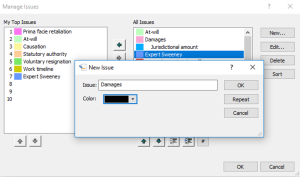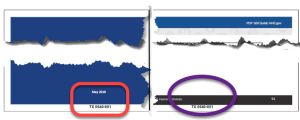Deposition Transcript Software – Q2 2023 Facts & Findings
Managing the multiple components of the litigation process can be both time-consuming and tedious. While litigation teams use many technology tools, my favorite is deposition transcript software (DTS). Using such software will save time and money. Unfortunately, I have also experienced the pain of quickly finding information from antiquated page/line summaries for the trial attorney.
DTS makes organizing, reviewing, preparing, and presenting deposition transcripts easier. Multiple DTS providers exist, but this discussion will not name or compare them. Instead, I plan to laud the use of this tool for most cases.
Often, deposition testimony is the chief way (and in private arbitration, sometimes there is no written discovery) to identify the issues, facts, documents, and witnesses. This article will focus on the use of DTS to streamline that process.

Organize
The first step in managing deposition transcripts is proper storage and organization. The organizational phase also includes tedious tasks such as tracking the exhibits used and changes made by the deponent. Most DTS systems allow you to quickly note the errata for each transcript and attach the signature page to the applicable transcript.
Westlaw Case Notebook (PTZ) and TextMap (XMEF) transcript delivery formats include hyperlinked exhibits and synchronized video/transcript. Check the DTS to confirm what file format is needed. I use the hyperlinked versions so I can have access to the actual exhibits. My selection allows the reviewers to open the exhibits via hyperlinks directly. There is no need to locate the exhibits by fumbling through folders or searching your document management system.
Organization of the transcripts and exhibits via a DTS system is a simple and effective way to centralize them. In addition, it is easy to run reports for your team. Two of them I frequently use are: (1) a list all of the deposition transcripts and (2) a list of all occurrences of exhibits in the transcript(s).
Setting up the naming conventions of files before importing into DTS will make it easier to sort or locate files. Trial Technologist Alicia Aquino suggests the following:
Steward_Anna_VDT_07_16_2023 (the user can see it was videotaped)
Steward_Anna_DT_07_16_2023 (this is full transcript)
Steward_Anna_CDT_07_16_2023 (this is the mini transcript)
If I do not have the linked transcript, Alicia Aquino suggests using the bulk rename utility to add the deponent’s name to each respective exhibit (i.e. Exhibit 001 to Steward, Steward 002, etc.)
Review
The first step in this process is importing electronic transcripts into the review platform. The DTS allows for annotation by more than one team member as they review the documents, including leaving notes. The tedious process of reading, reviewing, and annotating deposition transcripts during the pretrial phase is vital. In addition, DTS will allow the coordination of the vast amount of information gleaned from testimony.
We have all had a moment where we remember reading something from a transcript but cannot find that portion of testimony. Annotating the deposition transcripts while you review them allows you to mark portions of testimony by issue or make notes for others to see when they review the same section. The annotations should be tailored to the type of case. For instance, if there were two distinct types of law in a complex litigation matter, you could view the transcripts with annotations regarding only the applicable issues.

The image above provides one example of how issues are set up for an employment-type litigation. You can import the list of issues (via a csv spreadsheet) from your database or case management system.
Prepare
Annotating the deposition transcript during review is an empowering way to gather the details needed for the trial team to formulate a successful strategy. The relevant testimony regarding a document or witness during several sessions can be quickly tagged. It is then easy for the trial attorney to review the relevant portions without searching or reviewing the transcripts again.
For example, if an expert witness for opposing counsel changes his opinion about an exhibit or an issue during trial, the testimony can be located quickly. DTS allows your team additional time to digest this information and confer with the client or expert.
There are multiple types of reports to assist the trial teams. Below is a chart summarizing some report types:
| Report Type | Potential Use | Example of Report |
|---|---|---|
| Issues | Creating a list of the issues in a litigation (causes of action, matters in dispute, specific allegations) allows for easy information management. | A report of all the annotations in the case for all depositions to date or for a select number of depositions. The content can also be sorted by issue or narrowed to selected items. |
| Witnesses |
People rarely use their formal name or full name during their entire testimony. You can annotate all the testimony regarding a specific witness. |
List all of the annotations about witnesses. This report can be essential to an attorney or paralegal outlining examination or cross-examination questions. |
| Key Facts | Annotations regarding key facts can provide details regarding dates, amounts, or specifications. | Facts are also related to issues but are generally straightforward things like dates, invoice numbers, or amounts. Running a full report with all annotations can be helpful. I suggest sorting the report by deponents or issues. |
| Full-Text Search | Locate search phrases or search terms within transcripts. | The report will provide all occurrences of a selected search term or phrase. |
| Designation Lists | Selecting what testimony will be read or played to the arbitrator or jury is painless. | This information is used for meet and confer regarding counter-designations, supplemental designations, or objections. |
Exhibits
The planning, preparation, and presentation of exhibits includes considering multiple items. Knowing what the court or arbitrator requires is the first significant step in the workflow. The other factor that is frequently overlooked is cooperating with opposing counsel on such items as removing duplicate exhibits and exchanging the designation of deposition testimony. A paralegal’s first task is normally to draft the exhibit list. Sometimes the court determines the format of the exhibit list.
Below is an example [1] taken from the San Diego Superior Court forms:

Alternatively, below is an example [2] for a Federal Court Exhibit list:

The standardized naming and detailing of the trial exhibit are the hallmarks of an impressive and useful list. When using electronic exhibits, it is paramount to mark them with both the exhibit and page numbers. Many courts require the page number to be included when branding exhibits. Additionally, you must plan for the requirement to sequentially number each page of the trial exhibits.
As a generic example of requirements, below are two important rules from the Local Rules of the Superior Court of California County of Los Angeles:
| Rule | Details | Notes |
|---|---|---|
| 3.52 | All exhibits must be exchanged and pre-numbered, except those anticipated in good faith to be used for impeachment. All exhibits must be pre-numbered before any reference thereto by counsel or a witness. | The date for exchange of exhibits is an important factor. |
| 3.53 | The most efficient method of marking exhibits is the use of Arabic numerals in which each party is allocated a block of numbers to be used sequentially. For instance, the plaintiff may be allocated numbers 1 to 200, the first defendant numbers 201 to 400, and the second defendant numbers 401 to 600. Documentary exhibits consisting of more than one page must be internally paginated in sequential numerical order to facilitate reference to the document during interrogation of witnesses. | The use of electronic exhibits makes numbering easier. |
Present
Many paralegals have dealt with the question of: What should I do with the recording of this deposition? DTS stores the video of the deposition so you can easily access it. For example, creating clips to display witness testimony during a hearing or trial will be necessary. In addition, it is important to consider synching the video to the transcript so that the text can scroll on the screen next to the video.
The judge will require that the counsel meet and confer before a video of deposition testimony is played. Normally, the videotape deposition is permitted to the extent the parties agree on admissibility or edit to resolve objections.
The presentation of evidence during trial includes displaying portions of deposition testimony as well as the exhibits that testimony references.
General Tips for Deposition Transcript/Exhibit Management
I have taken time to include multiple tips because I want everyone to prepare for trial or arbitration with the benefit of some help. The help is in the form of a list, but it can save you valuable time. It will also allow you to think through other potential problems in advance. Some of my favorites: (1) How do I get that 50-gallon drum to the courthouse? (2) Is that government document admissible? Do I need a certified copy of it? (3) Where do I store tangible evidence before it is introduced?
Information/Tips
- Use a master deposition transcript exhibit index (This will prevent duplicate exhibit numbers). If all the parties stipulate to the use of one specific court reporter company, that agency would be responsible for creating and maintaining the list.
- Do not use alphabetical identification for deposition exhibit designations.
- Number the exhibits sequentially.
- Do not use subparts: Exhibit 104.b or 104(b) or 104B
- Set up the issue tags for annotation before the first deposition (Often, the issue tags can be taken from the database coding panel).
- Determine the transcript file format needed [a chart regarding transcript file formats is shown later [a]] and provide that information to the court reporter agency before the first deposition. Make it a standing order for your team or firm.
- When the transcript repository (DTS) is set up, offer to provide a short demonstration via Zoom. The team will not learn how to use the system from this demonstration. Instead, the session will provide an overview of the capabilities.
- Email the team about access to the repository, and include a document listing the issue tags and a simple instruction guide.
- Keep a tracking list for the deposition transcripts that includes multiple categories, such as whether it was videotaped, exhibit numbers, the designation number of prior exhibits reused, the attorney who attended, and details regarding the witness, date, time, and volume.
- Establish a naming method for the transcripts before you create the repository. Examples:
Smith, Joe 2022-06-01 Volume 1 (name)
2022-06-01 Smith, Joe Volume 1 (date)
I prefer starting the file name with the date of the deposition for smaller cases and the name for larger cases. - If clips from a videotaped deposition will be displayed at trial, synchronize the contents, and test them. Also, set up a standing order with the court reporter agency for the files you will need.
- The trial exhibit list should have the following information at a minimum. I like to include the page count as a category, but this is optional and not frequently done.
- Exhibit number
- Description of the exhibit
- Date
- Type of document or tangible thing
- Short/concise details
- If correspondence or email, include who it is from and who it is to
- Bates number range
- Offered into evidence
- Objection (if any)
- Admitted (or Date Admitted)
- Ensure your trial exhibit list provides a cross-reference to the deposition exhibit number. The best-case scenario is that using a master exhibit list will allow all parties to use the deposition exhibit numbers jointly.
- Check with the court clerk and court rules regarding what type of exhibit stamp is necessary.
- One potential method is to have a vendor brand (stamp) the exhibits with footers with the numbering data, such as “TX 0540-Page 1.” This allows counsel, witnesses, the court clerk, or the judge to refer to the exact page of an exhibit. The exhibit presentation on the screen shows exactly which page number is being displayed. Standard and consistent numbering is mandatory because the judge or arbitrator does not want the testimony to stop because the exhibit on display is not identified. An image of this type of marking is below.
- The exchange of transcript designations, objections, and counter-designations is tedious, but using DTS simplifies it. Check the court’s local rules, department rules, or standing orders for instructions or requirements regarding this task.
- Providing documents to impeach a witness will take planning. For example, where are the exhibit(s) or clips of testimony needed by the attorney to impeach the witness? Be prepared! Impeachment exhibits are NOT always listed on the exhibit list. Marking the exhibit with the trial exhibit number can be tricky. Providing a copy of the impeachment exhibit to counsel during virtual hearings will be necessary. Consider how that is to be done. How to present that evidence is also an issue. Does the attorney want to display relevant portions side-by-side?
- Deposition transcript reports of testimony to be displayed or read into the record need to have the trial exhibit number referenced. See item 13 above. No one has to cross-reference documents if you also use the deposition exhibit numbers as the trial exhibit number.
Below is an example of tip number 15. This image shows the first page and last page of an exhibit.

Advice from a Technologist on DTS
Below is a quote from attorney and legal tech author Nicole Black, discussing her opinion on using DTS in her article for the ABA Journal:
“Another technology tool designed to streamline the litigation process is deposition review software, which assists lawyers with the typically tedious process of reading, reviewing and annotating deposition transcripts during the pretrial process. These programs enable paperless depositions by storing digital transcripts in the cloud, which are then accessible from any compatible device.
Using this software, lawyers can read, highlight and share deposition and trial transcripts. It facilitates the analysis and review of deposition transcripts, and typically includes features that allow lawyers to highlight text with color-coded designations, search for specific phrases, flag important sections, generate reports and share the reports or flagged portions of the transcript.” [3] Nicole Black
On a separate note, I found DTS to be an excellent method for storing the dailies provided during trial or arbitration. It takes five minutes (at most) to upload a rough transcript into the system. DTS is a great way to provide selected testimony from that day to another team member or to copy and paste prior testimony into examination outlines.
Conclusion
The benefits of using DTS instead of the normal methods must be considered. Legal professionals must learn to use the available technology tools to increase our value to the companies and clients we serve.
Resources
[1] sdcourt.ca.gov/pls/portal/docs/page/sdcourt/generalinformation/forms/civilforms/civ252.pdf
[2] Thomas Reuters – Summer 2022 | Practical Law, page 37
[3] abajournal.com/news/article/simplify_a_tedious_deposition_review_with_technology
[a] Transcript File Formats
| TYPE | DETAILS |
| LEF | LEF is a file format that enables you to receive transcripts with the related evidence seamlessly integrated and ready for import into LiveNote. A LEF file can contain all the deposition exhibits already scanned and hyperlinked into the text, ready for import into LiveNote. |
| PTX | RealLegal™ E-Transcript™ file (Referred to frequently as an E-Transcript) |
| PTZ | RealLegal™ E-Transcript™ Bundle Viewer (exhibits) |
| TextMap
(XMEF) |
This software is provided to court reporters, vendors, and law firm staff to create TextMap Exhibit Packages (.xmef), which you can import into TextMap. In addition, DTS simplifies adding hyperlinked exhibit files to an ASCII or PTF text file of a deposition or other transcript. |
| TXT/ASCII | Only retains the transcript. |
| CMS | NativeTrial Director |
| MDB | A synchronized transcript database is created with Sanction and the corresponding .mdb (Exhibits are usually retained). |
Author Biography:
 Sheila Grela, ACP, is a seasoned litigation paralegal who obtained a paralegal certificate, with honors, from the ABA-approved USD Paralegal Program. Sheila has advanced her paralegal training by becoming both a Certified eDiscovery Specialist (CEDS) and an Advanced Certified Paralegal (ACP) in eDiscovery. Additionally, her eDiscovery accomplishments were acknowledged when she was appointed to be a Global Advisory Council participant for the Electronic Discovery Reference Model (EDRM) in 2020. Sheila is a fierce advocate for training, education, mentorship, and professional development for the paralegal community. She is heavily involved in the California Alliance of Paralegals (CAPA), the San Diego Paralegal Association (SDPA), and the San Diego chapter of Women in eDiscovery.
Sheila Grela, ACP, is a seasoned litigation paralegal who obtained a paralegal certificate, with honors, from the ABA-approved USD Paralegal Program. Sheila has advanced her paralegal training by becoming both a Certified eDiscovery Specialist (CEDS) and an Advanced Certified Paralegal (ACP) in eDiscovery. Additionally, her eDiscovery accomplishments were acknowledged when she was appointed to be a Global Advisory Council participant for the Electronic Discovery Reference Model (EDRM) in 2020. Sheila is a fierce advocate for training, education, mentorship, and professional development for the paralegal community. She is heavily involved in the California Alliance of Paralegals (CAPA), the San Diego Paralegal Association (SDPA), and the San Diego chapter of Women in eDiscovery.
Email: Sheila.Grela@procopio.com


 Categories
Categories